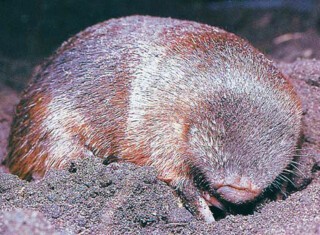The word iridescent comes from the Greek for ‘rainbow’, iris, and the Latin suffix, escent, ‘having a tendency towards’. Iridescence turns up in many insects, some birds, the odd squid: but in only one mammal, the golden mole. Some species are black, some metallic silver or tawny yellow, but under different lights and from different angles, their fur shifts through turquoise, navy, purple, gold. Moles, then, with a tendency towards sky colours.
The golden mole is not, in fact, a mole. It’s more closely related to the elephant, and though most are small enough to fit in a child’s hand, their bodies are miniature powerhouses: their kidneys are so efficient that many species can go their entire lives without drinking a drop of water. The bone in the mole’s middle ear is so large and hypertrophied that it is immensely sensitive to underground vibrations; waiting under the soil or sand, the golden mole can hear the footsteps up above of birds and lizards; it can distinguish between the footfall of ants and termites. With their powerful forelegs and webbed back feet, they are described by scientists as ‘spectacularly autapomorphic’. They have been like nothing but themselves for far longer than us: there are fossil specimens dating back to the Miocene period, which extends from about five million years ago to about 23 million years ago. They have been shining for a very long time.
There are 21 species, all from Sub-Saharan Africa; as is the way of these things, many of them are named after men. There’s Grant’s golden mole (just 8 cm long, found only in the Namibian desert, known as the ‘dune shark’) and Marley’s golden mole (reddish-brown, found only on two small patches of land on the eastern slopes of the Lebombo Mountains), the robust golden mole (not robust at all: it’s dying out due to sweeping habitat loss in South Africa) and the largest species, the giant golden mole. At 23 cm in length, it could take all the others in a fight, but is no match for our destructive impulses, our forest clearances and mining, and is the most endangered of the golden moles. Of the 21 species, more than half are currently threatened with extinction due to pollution and loss of habitat: if we lose them, we will have lost the world’s only rainbow mammal, a stupidity so grotesque we could not expect to be forgiven.
And then there is the 21st species, the Somali golden mole; the Bigfoot of golden moles, which has never been seen alive. In 1964, Alberto Simonetta, a professor at the Florence Institute of Zoology, was sifting through the contents of a disused bakery oven in Somalia. A family of barn owls had been living in it, and inside one of the pellets, Simonetta found the assorted bones of a golden mole; including the ‘right ramus of the lower jaw’. This tiny jawbone, barely larger than a thumbnail clipping, did not match that of any other known mole, and so the Calcochloris tytonis – the Somali golden mole – was added to the species list. Simonetta hunted for the living version, promising children a shilling for every specimen produced, but none was forthcoming, and the only record of its life is his 29-page paper, ‘A New Golden Mole from Somalia with an Appendix on the Taxonomy of the Family Chrysochloridae’. The Somali golden mole is listed on the International Union for the Conservation of Nature’s Red List of Threatened Species as ‘data deficient’. This is a category applied to 14 per cent of all mammals: a reminder that we do not know what shares the world with us, and in what numbers. We know very little about any golden mole, but about the Somali golden mole we know nothing at all; not what colour it is, nor whether it’s quietly abundant in some small and as yet unsurveyed patch of land, nor if the owl ate the last one.
Perhaps the greatest mystery is why the golden mole has evolved to glow. Iridescence occurs when an object’s physical structure causes lightwaves to combine, seeming to shift between multiple colours: the phenomenon is well represented in the natural world, but there always seems to be an obvious purpose for it. The Morpho butterfly, for instance, has a sweep of blue across its wings so bright and so complex we haven’t yet been able to replicate it; it’s thought to use its iridescence to communicate with other Morpho butterflies over long distances, using its wings to reflect ultraviolet light. The male rufous hummingbird has an iridescent orange bib, like a Renaissance ruff rendered in Technicolor; when trying to attract a mate, it fluffs up its neck feathers and soars into the sky, then dives down so fast you can hear the air part around it. Once, drunk and on Valentine’s day, I tried to share a portion of fried chicken with a club-footed London pigeon – and saw in the streetlight for the first time the way the iridescent plumage on their necks, caught at the right angle, shifts between teal and magenta.
All of these creatures are iridescent for a reason. But the golden mole is blind. Its eyes are covered with a layer of skin and fur, and it has never seen its own radiance. It lives almost entirely underground, in the cooler depths of earth and sand 50 cm below the surface, emerging only to hunt for insects. It’s currently thought that the fur evolved to be highly flattened, hard-wearing and low-friction to make burrowing easier; the iridescence is a by-product. So they burrow and breed and hunt, live and die under the African sun, unaware of their beauty, unknowingly shining.
Send Letters To:
The Editor
London Review of Books,
28 Little Russell Street
London, WC1A 2HN
letters@lrb.co.uk
Please include name, address, and a telephone number.



